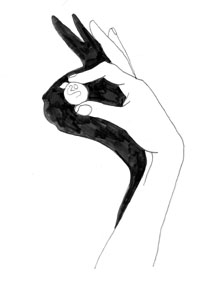
The Electrification of Consumer Brains, a collaboration between Dmitry Vilensky and myself opens tomorrow at the Motorenhalle, Dresden, Germany. The work includes drawings, a publication, a poster campaign and a performance and will also be made into a film.
.
A Few Simple Steps to a Stunning Magic Trick Performed Completely By the Spectator
Introduction: The magician asks the spectator: do you know any magic tricks? Whatever the spectator answers, the magician says "Well, here’s a great trick, only YOU'RE going to perform it."
The fetishism of the commodity — the domination of society by “intangible as well as tangible things” — attains its ultimate fulfillment in the spectacle, where the real world is replaced by a selection of illusions yet which at the same time succeed in making themselves be regarded as the epitome of reality. It’s a great trick – all the better because we ALL participate in the performance.
The Illusion: The spectator holds up a deck of cards, the magician points to one card which the spectator removes and places face down upon the table without looking at it. The spectator after some manipulation, ends up with two piles of cards on the table. The top cards on each pile are turned over, and, like magic one reveals the value of the selected card while the other reveals the suit.
Economic growth has liberated societies from the natural pressures that forced them into an immediate struggle for survival; but they have not yet been liberated from their liberator. The commodity’s independence has spread to the entire economy it now dominates. This economy has transformed the world, but it has merely transformed it into a world dominated by the economy.
The pseudo-nature within which human labor has become alienated demands that such labor remain forever in its service; and since this demand is formulated by and answerable only to itself, it in fact ends up channeling all socially permitted projects and endeavors into its own reinforcement. Thus we may not yet know how the trick works but we always know the value of the card and the importance of the suit.
The Performance: This trick is actually not too difficult, but the effect is astonishing because the magician never actually handles the deck all the work is done by the spectator. The only real skills necessary are good verbal communications and misdirection.
Whereas during the primitive stage of capitalist accumulation “political economy considers the spectator only as a worker,” who only needs to be allotted the indispensable minimum for maintaining his labor power, and never considers him or her their leisure and humanity, this perspective is revised as soon as commodity abundance reaches a level that requires an additional collaboration from the spectator.
Once the workday is over, the spectator is suddenly redeemed from the total contempt toward him or her that is so clearly implied by every aspect of the organization and surveillance of production, and finds him or herself seemingly treated like a grownup, with a great show of politeness, in his new role as a fellow magician. At this point the humanism of the commodity takes charge of the worker’s “leisure and humanity” simply because political economy now can and must dominate those spheres as political economy. It’s a great trick - the “perfected denial of humanity” has thus taken charge of all human existence.
The Trick: The spectator shuffles the deck and fans the cards in front of his or her face with the backs of the cards towards him or herself. Meanwhile, the Magician watches for the card that has the same value as the top card and the same suit as the card second from top.
The Spectator puts the cards down and deals the cards alternately into two piles. The Magician explains to the spectator that if he or she has been concentrating on the card on the table, he or she will have subconsciously picked two cards that will respectively reveal the value and suit of the card that the magician have randomly selected. Flip the three cards to reveal that this is so.
The constant decline of use value that has always characterized the capitalist economy has given rise to a new form of poverty within the realm of augmented survival — alongside the old poverty which still persists, since the vast majority of people are still forced to take part as wage workers in the unending pursuit of the system’s ends and each of them knows that he must submit or die. The reality of this blackmail — the fact that even in its most impoverished forms (food, shelter) use value now has no existence outside the illusory riches of augmented survival — accounts for the general subconscious acceptance of the illusions of modern commodity consumption. The real consumer has become a consumer of illusions. And the most astonishing part of the trick is that we go to the magic show, having lost our belief in magic, but wanting to be fooled regardless.
Next Trick how to pull a rabbit from a hat with one easy sleight of hand…








